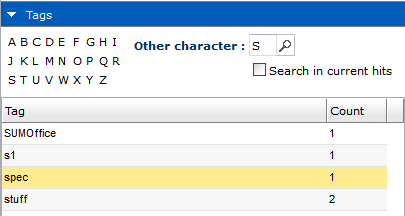The full-text search allows you to search in the contents of the documents. To perform this kind of search you have to enter a text expression.

It is possible to restrict the search to a single folder or apply some other filters as you see in the form. The text expression will be searched in the content of the document and in the other checked fields in Search in section.
This eliminates any confusion and makes sure you that effort must exist and either term computational or objects may exist.
Indexing required
Documents are not immediately available for full-text searches: they require to be indexed by the search engine first, by default this happen after 30 minutes but in general this depends on your system's configuration.
As expression you can use any words composition and in addition you can use special characters.
Wildcard Searches
To perform a single character wildcard search use the "?" symbol.
To perform a multiple character wildcard search use the "*" symbol.
The single character wildcard search looks for terms that match that with the single character replaced. For example, to search for "text" or "test" you can use the search:
te?t
Multiple character wildcard searches looks for 0 or more characters. For example, to search for test, tests or tester, you can use the search:
test*
You can also use the wildcard searches in the middle of a term.
te*t
Boolean Operators
Boolean operators allow terms to be combined through logic operators. The search system supports AND, "+", OR, NOT and "-" as Boolean operators. Note that these operators are all CAPS.
The OR operator is the default conjunction operator. This means that if there is no Boolean operator between two terms, the OR operator is used. The OR operator links two terms and finds a matching document if either of the terms exist in a document. This is equivalent to a union using sets. The symbol || can be used in place of the word OR.
To search for documents that contain either "computational objects" or just "computational" use the query:
"computational objects" computational
or
"computational objects" OR computational
AND
The AND operator matches documents where both terms exist anywhere in the text of a single document. This is equivalent to an intersection using sets. The symbol && can be used in place of the word AND.
To search for documents that contain "computational objects" and "Computational effort" use the query:
"computational objects" AND "Computational Effort"
+
The "+" or required operator requires that the term after the "+" symbol exist somewhere in a the field of a single document.
To search for documents that must contain "computational" and may contain "objects" use the query:
+computational objects
NOT
The NOT operator excludes documents that contain the term after NOT. This is equivalent to a difference using sets. The symbol ! can be used in place of the word NOT.
To search for documents that contain "computational objects" but not "Computational effort" use the query:
"computational objects" NOT "Computational effort"
Note: The NOT operator cannot be used with just one term. For example, the following search will return no results:
NOT "computational objects"
-
The "-" or prohibit operator excludes documents that contain the term after the "-" symbol.
To search for documents that contain "computational objects" but not "Computational effort" use the query:
"computational objects" -"Computational effort"
Grouping
You can use parentheses to group clauses to form sub queries. This can be very useful if you want to control the boolean logic for a query.
To search for either "computational" or "objects" and "effort" use the query:
(computational OR objects) AND effort
![]()








